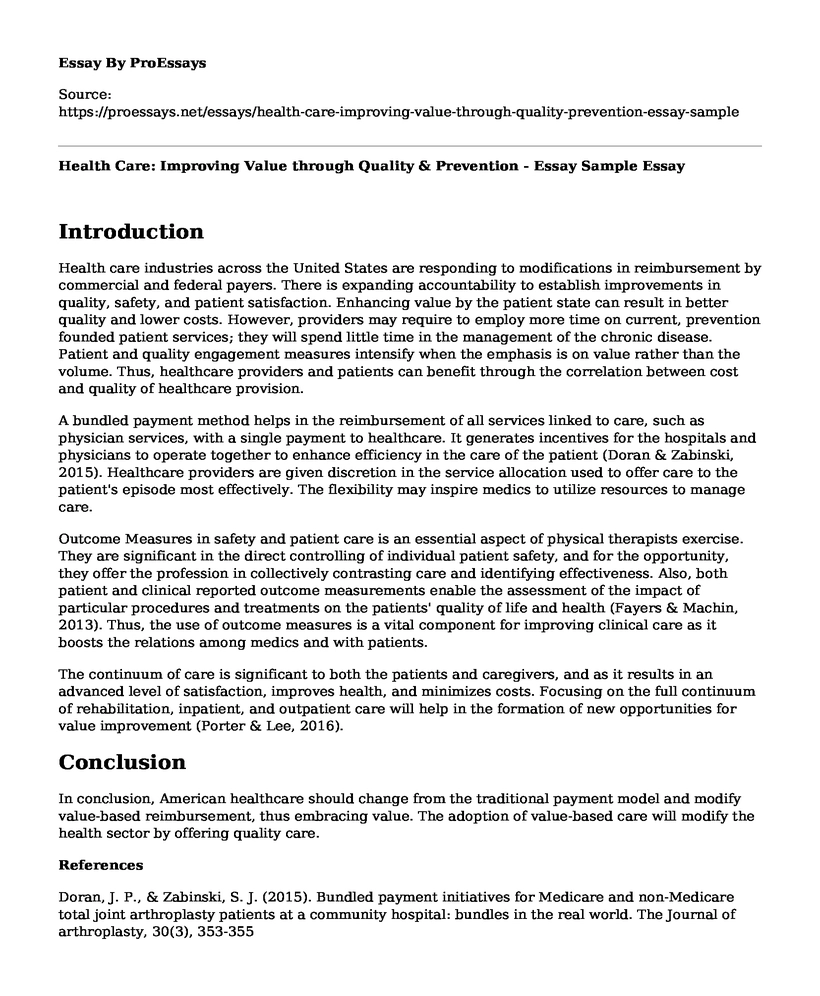Introduction
Health care industries across the United States are responding to modifications in reimbursement by commercial and federal payers. There is expanding accountability to establish improvements in quality, safety, and patient satisfaction. Enhancing value by the patient state can result in better quality and lower costs. However, providers may require to employ more time on current, prevention founded patient services; they will spend little time in the management of the chronic disease. Patient and quality engagement measures intensify when the emphasis is on value rather than the volume. Thus, healthcare providers and patients can benefit through the correlation between cost and quality of healthcare provision.
A bundled payment method helps in the reimbursement of all services linked to care, such as physician services, with a single payment to healthcare. It generates incentives for the hospitals and physicians to operate together to enhance efficiency in the care of the patient (Doran & Zabinski, 2015). Healthcare providers are given discretion in the service allocation used to offer care to the patient's episode most effectively. The flexibility may inspire medics to utilize resources to manage care.
Outcome Measures in safety and patient care is an essential aspect of physical therapists exercise. They are significant in the direct controlling of individual patient safety, and for the opportunity, they offer the profession in collectively contrasting care and identifying effectiveness. Also, both patient and clinical reported outcome measurements enable the assessment of the impact of particular procedures and treatments on the patients' quality of life and health (Fayers & Machin, 2013). Thus, the use of outcome measures is a vital component for improving clinical care as it boosts the relations among medics and with patients.
The continuum of care is significant to both the patients and caregivers, and as it results in an advanced level of satisfaction, improves health, and minimizes costs. Focusing on the full continuum of rehabilitation, inpatient, and outpatient care will help in the formation of new opportunities for value improvement (Porter & Lee, 2016).
Conclusion
In conclusion, American healthcare should change from the traditional payment model and modify value-based reimbursement, thus embracing value. The adoption of value-based care will modify the health sector by offering quality care.
References
Doran, J. P., & Zabinski, S. J. (2015). Bundled payment initiatives for Medicare and non-Medicare total joint arthroplasty patients at a community hospital: bundles in the real world. The Journal of arthroplasty, 30(3), 353-355
Fayers, P. M., & Machin, D. (2013). Quality of life: the assessment, analysis, and interpretation of patient-reported outcomes. John Wiley & Sons.
Porter, M. E., & Lee, T. H. (2016). From volume to value in health care: the work begins. Jama, 316(10), 1047-1048.
Cite this page
Health Care: Improving Value through Quality & Prevention - Essay Sample. (2023, Aug 10). Retrieved from https://proessays.net/essays/health-care-improving-value-through-quality-prevention-essay-sample
If you are the original author of this essay and no longer wish to have it published on the ProEssays website, please click below to request its removal:
- Paper Example on Effective Nursing Practice for Norovirus
- Patient Teaching Plan for Type 1 Diabetes Essay
- Vegan Diet Essay Example
- Abortion: Should It Be Part of Typical Practices? - Essay Sample
- Essay on Community-Based Nursing: A Catalyst for Quality Care and Improved Outcomes
- Firefighters: Mental & Physical Skills to Handle Disasters - Research Paper
- Essay Example on Robotic Companions: The Future of Human Life?







